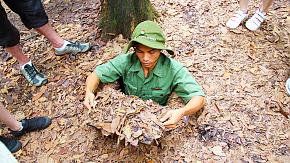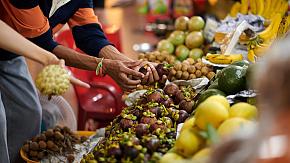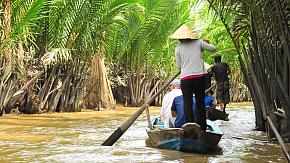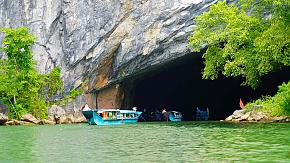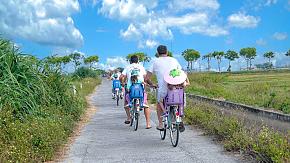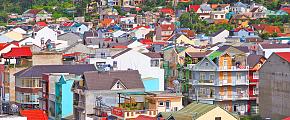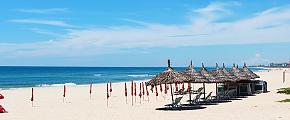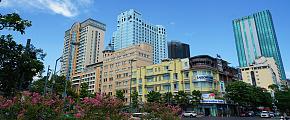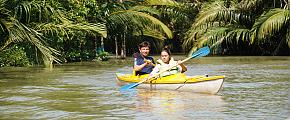Hanoi Travel Guide: Attractions, Food and More
Hanoi, the capital of Vietnam, is a city rich in history, both ancient and modern. It is also known for its beautiful lakes and vibrant gastronomy. It might be the favorite city in Southeast Asia for many. Here are some of its most important destinations and features, in the hope that they inspire a deep appreciation for the place.
Historical Attractions in Hanoi
One Pillar Pagoda (Chùa Một Cột)
Address: Pho Chua Mot Cot, Ban Dinh, Hanoi 100000
Tel: +84 335 611 213
Opening Hours: 7 am-6 pm daily
In 1049 AD, the Lý dynasty emperor, Lý Thái Tông built a special pagoda to thank the gods for bringing him a son. This wooden pagoda was built on a single 1.25 meter / 4-foot diameter, 4 meter / 13-foot tall pillar in a lotus pond. The pagoda is meant to represent a lotus flower, a holy plant for Buddhists, while the pillar is the stem.
For many years, the pagoda was the site of royal ceremonies marking the Buddha's birthday. Sadly, what you see today is a reconstruction, as the original pagoda was destroyed by vengeful, retreating French soldiers in 1954, when their colonial rule was overthrown. However, the reconstruction is faithful to the original and a pleasure to see.
Imperial Citadel of Thăng Long (Hoàng thành Thăng Long)
Address: 19C Hoang Dieu, Dien Bien, Hanoi 100000
Tel: +84 24 3734 5427
Opening Hours: 8 am-5 pm daily except Mondays
Also known as Hanoi Citadel, this UNESCO World Heritage Site was the imperial palace and seat of government from around 1010 until 1810 when the capital was moved to Huế by the Nguyễn dynasty. The once large complex of buildings fell into disrepair by the 19th century and many buildings were demolished in the 20th century. Recently, however, excavations have begun.
What can still be seen includes the famous 33.4 meter / 110 foot tall Flag Tower, often used as a symbol of the city; the North and South gates; and the steps which once led to the Kinh Thiên Palace.
From independence from France to the end of the Vietnam War, the citadel's grounds were used as the headquarters of the People's Army of Vietnam. In 1967, a house, code-named D67 was built for the top brass with a secret emergency evacuation tunnel. These are now open for viewing.
The Old Quarter (Phố cổ Hà Nội)
Just outside the citadel lies Hanoi's fascinating Old Quarter, also known as the "36 streets (Hà Nội 36 phố phường)", although there are actually a lot more than that. 36 refers to the number of craftsmen's guilds that operated here, each having a street dedicated to their trade and the materials used. You can still find the bamboo street, brass street, copper street, etc. Today a few streets still stick to their traditional use, but most are now mixed or have switched to new types of business while retaining the original name. Each guild built temples and pagodas, several of which remain.
 The Old Quarter
The Old Quarter
This was the main residential and business district of the city beginning in the Lý dynasty over 1,000 years ago. Most of what you see today however dates from the 18th and 19th centuries. However, the quarter is still Hanoi's main shopping area.
The architecture is an interesting mixture of traditional Vietnamese and colonial French and many of the old shops and houses have been converted into restaurants, cafés and small shops. Look out for Hanoi's best street food here in any of the small outlets that line the streets. Also, check out the lively and colorful Đồng Xuân Market (Chợ Đồng Xuân), Hanoi's largest covered market, built in 1889, but renovated many times, most recently in 1994 after a major fire. Here you can really see Hanoi life as people buy and sell everything from clothing to ingredients for dinner!
Temple of Literature (Văn Miếu)
Address: Quoc Tu Giam, Hanoi
Tel: 024-3845 2917
Opening Hours: 8 am-5 pm daily
Also founded in the Lý dynasty is the Temple of Literature, a Confucian temple which houses the Imperial Academy (Quốc Tử Giám), Vietnam's first university, where hopeful bureaucrats and nobles studied under their masters for the imperial exams, modeled on the Chinese exam system. Founded in 1070, the academy was active until 1779, when the Nguyễn dynasty shifted the seat of power to Huế.
Over the centuries, the temple has been rebuilt and restored several times and is now a timeline of Vietnam's architecture. Loosely modeled on the temple in Confucius's hometown of Qufu in Shandong province of China, the temple covers an area of 54,000 m² / 64,583 square yards including a lake, park, pavilions, and five beautiful courtyards. The first two of these courtyards were places of relaxation for the students and other occupants of the temple complex. The second contains the unique Khue Van pavilion (Khuê Văn Các). The third contains steles listing 1,307 successful candidates in the exams. Number four contains the Hall of Ceremonies where acts of worship to Confucius took place, while the last holds the academy itself.
Ho Chi Minh Complex
It is, of course, impossible to discuss Hanoi without mentioning either the struggle for independence from France or the Vietnam War, still in living memory for so many people. Saigon, in the south, was renamed Ho Chi Minh city after the war, but it is in Hanoi that the former leader mainly lived and worked. As a result, the city has a number of sites dedicated to his memory. It even has his embalmed body on display despite his expressed wish to be cremated.
• Presidential Palace
Address: Hung Vuong Street and Hoang Van Thu Street, Hanoi 118708
Tel: +84 80 43176
Opening Hours: Monday-Friday 7 am-4 pm
Built in 1900 by French architect Auguste Henri Vildieu in a French style, but heavily influenced by the Italian Renaissance, the palace was originally the Residence of the French Governor-General of Indochina and so the center of French colonialism.
After Ho led North Vietnam to independence in 1954 and assumed the presidency, the name was changed. However, it seems Ho never actually lived in the ornate palace, although he did use it on formal occasions for meetings and other official events. Instead, he had a modest, traditional, wooden stilt house built on the grounds, which he made his home.
The palace itself is not open to the public, but it is possible to walk in the grounds and gardens.
• Ho's House on Stilts
Address: No. 1 Bach Thao, Ngoc Ho Street, Hanoi 118322
Tel: +84 80 44287
Opening Hours: Monday 8 am-11 am; Tuesday-Sunday 8 am-5 pm
Ho's house is a small two-story building beside a carp pond, where he liked to relax by fishing. The house is open to the public and you can view his simple living arrangements.
• Ho Chi Minh Mausoleum (Lăng Chủ tịch Hồ Chí Minh)
Address: No. 2 Hung Vuong Street, Hanoi 100000
Tel: +84 24 3845 5128
Opening Hours: Mon 8 am-11 am; Tuesday-Sunday 8 am-5 pm
 Ho Chi Minh Mausoleum
Ho Chi Minh Mausoleum
Ho Chi Minh died in 1969, never seeing his country reunited, and despite his express wishes, his body was embalmed by Russian experts and "rests" on display in a specially built granite mausoleum on Ba Đình Square (Quảng Trường Ba Đình), where he is guarded around the clock by an honor guard from the Vietnamese army.
Visitors are required to dress appropriately (no shorts or short dresses, arms and shoulders must be covered, etc.) and bags and cameras are not allowed. It is expected that you file slowly past the body in respectful silence. Guards are in attendance to ensure the rules are enforced. Lines can be long here, so if you really want to see him, it is suggested you get there early in the morning.
• Ho Chi Minh Museum (Bảo tàng Hồ Chí Minh)
Address: 158/19 Ngoc Ha Street, Ban Dinh, Hanoi 100000
Tel: +84 24 3846 3757
Opening Hours: Tuesday to Sunday, 8 am-12 noon, 2-4:30 pm; Monday and Friday, 8 am-12 noon
This large museum contains eight major displays, each documenting various stages of Ho's life and influence. Exhibits are labeled in Vietnamese, English and French.
Hoa Lo Prison Museum (Hỏa Lò nhà tù)
Address: No. 1 Hoa Lo, Tran Hung Dao, Hoan Kiem, Hanoi 100000
Tel: +84 24 3934 2253
Opening Hours: 8 am-5 pm daily
Ho Luo Prison was built by the French to hold Vietnamese revolutionaries who were resisting the French colonialists, then in the Vietnam War became the main POW prison, ironically nicknamed "The Hanoi Hilton". The prison was mostly demolished in the mid-1990s and the site is now occupied by serviced apartments and shopping malls. However, one small part remains as Ho Luo Prison Museum, a rather bizarre place which claims that the nickname came about because the prisoners were so comfortable in their 5-star accommodation.
Natural Attractions in Hanoi
Situated on the lowland in the Red River delta, Hanoi is also known as the City of Lakes. Some of these lakes are popular leisure destinations for both visitors and the locals. Here are the three most popular:
Hoan Kiem Lake (Hồ Hoàn Kiếm)
Also, known as Sword Lake due to a legend that a 15th-century emperor was boating on the lake when a god in the shape of a turtle demanded that he return a sword which had previously been lent to him to help drive out the Ming dynasty Chinese. The 12 ha / 30 acre, freshwater lake lies in the center of Hanoi and is a popular recreation spot for locals, especially in the early morning and again in the cool of the evening.
 Hoan Kiem Lake
Hoan Kiem Lake
A favourite spot for photographs is the red bridge (Cầu Thê Húc) which leads across the lake to the attractive Temple of the Jade Mountain (Đền Ngọc Sơn).
West Lake (Hồ Tây)
With a shore length of 17 km (about 10.6 miles) and about 5 km² / 2 sq miles in area, West Lake is Hanoi's largest freshwater lake. It is adjacent to the Old Quarter and has many hotels and restaurants etc. It is also home to some of Hanoi's most expensive real estate, with rich locals and ex-pats buying up large homes.
In the center of the lake is the 6th century Buddhist Tran Quoc Pagoda (Chùa Trấn Quốc), Hanoi's oldest pagoda. It is still an active monastery and visitors go to burn incense and pray and often take small gifts of food and money, not for the monks, but for the gods.
Unusually, there are shrines to worship female Buddhas known as the "Mothers". Although today, considered part of Buddhism, these mothers were in fact worshiped in Vietnam long before Buddhism arrived.
Truc Bach Lake (Hồ Trúc Bạch)
Actually, this was part of West Lake until it was cut off from the main part by a dike built in the 17th century. A palace was built on the lake and used as a royal pleasure palace, but later turned into a prison for errant concubines, who took to passing their captivity by waving silk of the highest quality. In the USA, the lake is probably best known for being where the late senator and presidential candidate, John McCain was ditched after being shot down over Hanoi in 1967 and taken prisoner. He later served almost six years as a POW, part of which was in Hoa Lo prison in Hanoi.
Food in Hanoi
As ever, I cannot leave Vietnam without mentioning the cuisine, one of the world's best, and Hanoi just might be the best of the best. The city is home to several of Vietnam's best-known dishes. Here are but three.
Who doesn't know Vietnamese pho? This classic soupy rice noodle dish is believed by most experts to have originated in Hanoi, before spreading across all of Vietnam and then the world. Enjoy it at the source. In most places, it comes in two varieties, phở bò (beef) and phở gà (chicken) and is served with herbs, vegetables, and fresh lime juice.
Another popular Hanoi dish, also found across Vietnam and beyond, is bánh cuốn, which are thin sheets of ground rice batter topped with fried ground pork, mushroom, and shallots, then rolled up and served with the Vietnamese fish sauce, nước chấm as a dipping sauce.
But Hanoi's all-time favorite has to be bún chả, grilled pork belly with rice noodles and herbs. This is the dish US President Obama famously ate with the late Anthony Bourdain on his state visit to Vietnam in 2016. They accompanied the dish with chả cá, which are Vietnamese crab cakes, and Hanoi Beer. You could eat like a president and do the same! They ate at Bún Chả Hương Liên, which is at 24 Le Van Huu Street in Hai Ba Trung District, Hanoi. Tel: +84 24 3943 4106. Prepare for long lines but great food. Their menu now features "Bun Cha Obama", which is the meal they ate, but you can't sit at their table. It has been laid out for their meal and enclosed in plexiglass as a museum piece. If the restaurant is too busy for you, don't worry, many restaurants are now serving the same combo meal under the same name.
More Than Hanoi
Remember that Hanoi is an excellent base for touring northern Vietnam. The stunning Halong Bay is only about 3.5 hours away by car and a cruise here will be unforgettable. Also, relatively close to Hanoi (about 5 hours by car) is Sapa, which is home to several villages belonging to various Vietnamese ethnic minorities. Here you can trek among the mountains and rice terraces, visit the villages and share a meal with them. Also, an unforgettable experience.
 The ethnic minorities in Sapa
The ethnic minorities in Sapa
If you want to know more about these ethnic minority peoples, then back in Hanoi, you can visit The Vietnam Museum of Ethnology.
The Vietnam Museum of Ethnology (Bảo tàng Dân tộc học Việt Nam)
Address: Nguyen van Huyen Street, Cau Giay District, Hanoi 100000
Tel: +84 24 3756 2193
Opening Hours: 8:30 am-5:30 pm except Mondays
Opened in 1997 and located about 8 km / 5 miles from the city center, the 43,799 m²/10.823 acre museum is devoted to studying, documenting and explaining Vietnam's 54 ethnic groups. It is fascinating and informative.
Odynovo can design a custom-made tour for you in Hanoi taking in as many of these (and more) special sites as you wish or arrange similar unique itineraries to any of over thirty countries and cities around the world. Just tell us where you want to go and what you want to see and do (or ask for suggestions) and we'll get back to you within 24 hours.
Quick Question
Related Posts You May Like
What Our Clients Say
Explore the latest verified reviews of Odynovo's travel services on Tripadvisor, Google, Trustpilot, Product Review and more trusted platforms.

